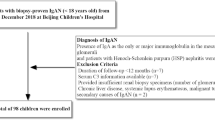Abstract
Mesangial hypercellularity (MH), in the absence of sclerosis or immune deposition, was a common finding on renal biopsy in our center. We studied 66 children with predominant MH. Among all patients older than 2.7 years, blood pressure (BP) percentile and glomerular filtration rate (GFR) remained stable. Serum albumin (Alb) trended higher (3.0 ± 0.2 start vs. 3.4 ± 0.2 end g/dl, p = 0.06) and urine protein/creatinine lower (4.2 ± 0.9 start vs. 2.3 ± 0.9 end mg/mg, p = 0.18) at the end of the study period. The proportion with stage 1 CKD remained constant: 94% start vs. 92% end. At end, Alb was lower in patients referred for nephrotic syndrome (NS): 4.4 ± 0.3 hematuria vs. 4.2 ± 0.2 proteinuria vs. 2.8 ± 0.3 NS g/dl, p < 0.05 vs. both. Alb was lower (p = 0.03) and urine protein/creatinine trended higher in patients with diffuse foot-process fusion (FPF). Twenty-five percent of patients with focal FPF developed NS, all had relapses, and 63% were steroid sensitive (SS). All but one with diffuse FPF presented with NS; 86% had relapses (mean 1 year) and 63% were SS. GFR trended higher at the end in those with matrix thickening (mat) (119.6 ± 4.7 no mat vs. 129.1 ± 2.6 mat ml/min per 1.73 m2, p = 0.1). Those without mat were less SS (59% no mat vs. 80% mat) and were more likely to require alkylating agents (Alk) for NS. Among those with positive immunofluorescence (IF), 82% had immunoglobulin M (IgM) alone; those with positive IF were more SS and needed Alk for NS. MH predicts a favorable prognosis. FPF predicts NS and multiple relapses.
Similar content being viewed by others
References
Schlondorff D (1987) The glomerular mesangial cell: an expanding role for a specialized pericyte. FASEB J 1:272–281
Hass M (2005) Histology and immunohistology of IgA nephropathy. J Nephrol 18:676–680
Lai KN, Chan LY, Leung JC (2005) Mechanisms of tubulointerstitial injury in IgA nephropathy. Kidney Int (Suppl) 94:S110–S115
Coppo R, Amore A (2004) Aberrant glycosylation in IgA nephropathy (IgAN). Kidney Int 65:1544–1547
Kurogi Y (2003) Mesangial cell proliferation inhibitors for the treatment of proliferative glomerular disease. Med Res Rev 23:15–31
Yung S, Tsang RC, Leung JK, Chan TM (2006) Increased mesangial cell hyaluronan expression in lupus nephritis is mediated by anti-DNA antibody-induced IL-1beta. Kidney Int 69:272–280
Chen M, Wang YY, Zhao MH, Zhang YK, Wang HY (2005) Autoantibodies against glomerular mesangial cells and their target antigens in lupus nephritis. Ren Fail 27:507–513
Allen WR, Travis LB, Cavallo T, Brouhard BH, Cunningham RJ (1982) Immune deposits and mesangial hypercellularity in minimal change nephrotic syndrome: Clinical relevance. J Pediatr 100:188–191
Southwest Pediatric Nephrology Study Group (1983) Childhood nephrotic syndrome associated with diffuse mesangial hypercellularity. A report of the Southwest Pediatric Study Group. Kidney Int 23:87–94
Habib R, Girardin E, Gagnadoux MF, Hinglais N, Levy M, Broyer M (1988) Immunopathological findings in idiopathic nephrosis: clinical significance of glomerular “immune deposits”. Pediatr Nephrol 2:402–408
International Study of Kidney Disease in Children (1978) Nephrotic syndrome in children: Prediction of histopathology from clinical and laboratory characteristics at time of diagnosis. A report of the International Study of Kidney Disease in Children. Kidney Int 13:159–165
National High Blood Pressure Education Program Working Group on high blood pressure in children and adolescents (2004) The fourth report on the diagnosis, evaluation, and treatment of high blood pressure in children and adolescents. Pediatrics 114 (2 Suppl):555–576
Joh K, Matsuyama N, Kanetsuna Y, Usui N, Hattori M, Yumura W, Aizawa S (1998) Nephrotic syndrome associated with diffuse mesangial hypercellularity: is it a heterogeneous disease entity? Am J Nephrol 18:214–220
Andal A, Saxena S, Chellani HK, Sharma S (1989) Pure mesangial proliferative glomerulonephritis. Nephron 51:314–319
Fries JWU, Rumpelt H-J, Thoenes W (1987) Alterations of glomerular podocytic processes in immunologically mediated glomerular diseases. Kidney Int 32:742–748
Powell HR (1976) Relationship between proteinuria and epithelial cell change in minimal lesion glomerulopathy. Nephron 16:310–317
Bohman S-O, Jarenko G, Bohlin AB, Berg U (1984) Foot process fusion and glomerular filtration rate in minimal change nephrotic syndrome. Kidney Int 25:696–700
Chana RS, Martin J, Rahman EU, Wheeler DC (2003) Monocyte adhesion to mesangial matrix modulates cytokine and metalloproteinase production. Kidney Int 63: 889–898
Ahmed AK, Haylor JL, El Nahas AM, Johnson TS (2007) Localization of matrix metalloproteinases and their inhibitors in experimental progressive kidney scarring. Kidney Int 71:755–763
McLennan SV, Kelly DJ, Schache M, Waltham M, Dy V, Langham RG, Yue DK, Gilbert RE (2007) Advanced glycation end products decrease mesangial cell MMP-7: a role in matrix accumulation in diabetic nephropathy? Kidney Int 72:481–488
Myllymäki J, Saha H, Mustonen J, Helin H, and Pastrenack A (2003) IgM nephropathy: clinical picture and long-term prognosis. Am J Kidney Dis 41:343–350
Saha H, Mustonen J, Pasternack A, Helin H (1989) Clinical follow-up of 54 patients with IgM-nephropathy. Am J Nephrol 9:124–128
Pardo V, Riesgo I, Zilleruelo G, Strauss J (1984) The clinical significance of mesangial IgM deposits and mesangial hypercellularity in minimal change nephrotic syndrome. Am J Kidney Dis 3:264–269
Author information
Authors and Affiliations
Corresponding author
Rights and permissions
About this article
Cite this article
Silverstein, D.M., Craver, R.D. Mesangial hypercellularity in children: presenting features and outcomes. Pediatr Nephrol 23, 921–928 (2008). https://doi.org/10.1007/s00467-008-0750-0
Received:
Revised:
Accepted:
Published:
Issue Date:
DOI: https://doi.org/10.1007/s00467-008-0750-0




